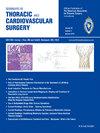Partial Heart Transplant Update: Where Are We In 2025?
IF 2.5
3区 医学
Q2 CARDIAC & CARDIOVASCULAR SYSTEMS
Seminars in Thoracic and Cardiovascular Surgery
Pub Date : 2025-06-01
DOI:10.1053/j.semtcvs.2025.03.002
引用次数: 0
Abstract
Partial heart transplantation (PHT) creates a new and innovative approach to allow for patient and disease tailored intervention with the ability to treat a larger patient base. It offers the growth capacity of a heart transplantation without the need for high dose immunosuppression. The importance of a valve replacement with the potential of growth is imperative in the pediatric population as these patients will otherwise outgrow their new valves requiring repeat and high-risk interventions. Adaptive valve growth has been observed prior to PHT, in the case of orthotopic heart transplantation and Ross pulmonary autografts. The first human PHT was performed in April of 2022 at Duke. The recipient was a 17-day old infant with truncus arteriosus and severe truncal valve regurgitation. The operation was a success and the transplanted PHT conduit showed appropriate adaptive valve growth. Due to the low immunogenicity and recipient endothelialization of the transplanted PHT graft, the immunosuppressive requirements for PHT patients are low. One of the benefits of PHT is that it utilizes hearts which would otherwise not be suitable for orthotopic heart transplantation. Furthermore, the prospect of domino and split root PHT increases the potential of ethical and efficient organ stewardship. Currently PHT is regulated by the Food and Drug Administration, a ruling which was released in early 2024 as human cells, tissues, or cellular or tissue-based products (HCT/Ps). This means it does not compete with hearts suitable for orthotopic heart transplantation which are regulated as organs under the Organ Procurement and Transplantation Network (OPTN).
部分心脏移植更新:2025年我们在哪里?
部分心脏移植(PHT)创造了一种新的创新方法,允许对患者和疾病进行量身定制的干预,能够治疗更大的患者群体。它提供了心脏移植的生长能力,而不需要高剂量的免疫抑制。具有生长潜力的瓣膜置换术的重要性在儿科人群中是必不可少的,因为这些患者将无法生长出新的瓣膜,需要重复和高风险的干预。在原位心脏移植和罗斯自体肺移植的情况下,在PHT之前观察到适应性瓣膜生长。首例人体PHT于2022年4月在杜克大学进行。受体是一名17天大的婴儿,患有动脉干和严重的主动脉瓣反流。手术成功,移植的PHT导管显示出适当的适应性瓣膜生长。由于移植的PHT移植物具有低免疫原性和受体内皮化,因此PHT患者的免疫抑制需求较低。PHT的好处之一是它利用了原本不适合原位心脏移植的心脏。此外,多米诺骨牌和劈根PHT的前景增加了道德和有效的器官管理的潜力。目前PHT是由FDA监管的,该裁决于2024年初发布,作为人类细胞、组织或细胞或组织产品(HCT/Ps)。这意味着它不会与适合原位心脏移植的心脏竞争,原位心脏移植是OPTN规定的器官。
本文章由计算机程序翻译,如有差异,请以英文原文为准。
求助全文
约1分钟内获得全文
求助全文
来源期刊

Seminars in Thoracic and Cardiovascular Surgery
Medicine-Pulmonary and Respiratory Medicine
CiteScore
5.80
自引率
0.00%
发文量
324
审稿时长
12 days
期刊介绍:
Seminars in Thoracic and Cardiovascular Surgery is devoted to providing a forum for cardiothoracic surgeons to disseminate and discuss important new information and to gain insight into unresolved areas of question in the specialty. Each issue presents readers with a selection of original peer-reviewed articles accompanied by editorial commentary from specialists in the field. In addition, readers are offered valuable invited articles: State of Views editorials and Current Readings highlighting the latest contributions on central or controversial issues. Another prized feature is expert roundtable discussions in which experts debate critical questions for cardiothoracic treatment and care. Seminars is an invitation-only publication that receives original submissions transferred ONLY from its sister publication, The Journal of Thoracic and Cardiovascular Surgery. As we continue to expand the reach of the Journal, we will explore the possibility of accepting unsolicited manuscripts in the future.
 求助内容:
求助内容: 应助结果提醒方式:
应助结果提醒方式:


